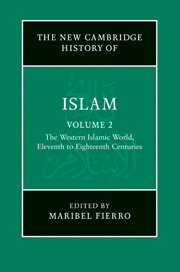Book contents
- Frontmatter
- Introduction
- PART I AL-ANDALUS AND NORTH AND WEST AFRICA (ELEVENTH TO FIFTEENTH CENTURIES)
- PART II EGYPT AND SYRIA (ELEVENTH CENTURY UNTIL THE OTTOMAN CONQUEST)
- PART III MUSLIM ANATOLIA AND THE OTTOMAN EMPIRE
- PART IV NORTH AND WEST AFRICA (SIXTEENTH TO EIGHTEENTH CENTURIES)
- 16 Sharīfian rule in Morocco (tenth–twelfth/sixteenth–eighteenth centuries)
- 17 West Africa (tenth–twelfth/sixteenth–eighteenth centuries)
- 18 Ottoman Maghrib
- PART V RULERS, SOLDIERS, PEASANTS, SCHOLARS AND TRADERS
- Glossary
- Bibliography
- Index
- References
16 - Sharīfian rule in Morocco (tenth–twelfth/sixteenth–eighteenth centuries)
from PART IV - NORTH AND WEST AFRICA (SIXTEENTH TO EIGHTEENTH CENTURIES)
Published online by Cambridge University Press: 28 March 2011
- Frontmatter
- Introduction
- PART I AL-ANDALUS AND NORTH AND WEST AFRICA (ELEVENTH TO FIFTEENTH CENTURIES)
- PART II EGYPT AND SYRIA (ELEVENTH CENTURY UNTIL THE OTTOMAN CONQUEST)
- PART III MUSLIM ANATOLIA AND THE OTTOMAN EMPIRE
- PART IV NORTH AND WEST AFRICA (SIXTEENTH TO EIGHTEENTH CENTURIES)
- 16 Sharīfian rule in Morocco (tenth–twelfth/sixteenth–eighteenth centuries)
- 17 West Africa (tenth–twelfth/sixteenth–eighteenth centuries)
- 18 Ottoman Maghrib
- PART V RULERS, SOLDIERS, PEASANTS, SCHOLARS AND TRADERS
- Glossary
- Bibliography
- Index
- References
Summary
Introduction
The early modern period was a time of transition for Morocco. Located close to western Europe, Morocco could not avoid being impacted by the changes going on in that continent. The country was significantly affected by the completion of the Christian reconquista of Iberia in 897/1492, along with the ongoing struggles and ultimate expulsion of the Moriscos and ‘New Christians’. Since the Portuguese launched their first colonial enterprise in Morocco, and Spain later established outposts along the North African coastline, Morocco would become one of the first Islamic countries to be confronted with European imperial ambitions.
In addition, Moroccan autonomy was threatened from the east by Ottoman expansion into North Africa during the early tenth/sixteenth century. The Ottomans presented a unique challenge in that, as co-religionists, they appealed to Moroccan leaders in the name of Islamic unity and as defenders of the abode of Islam (dār al-islām) from the Christian Europeans. Nevertheless, Ottoman ‘protection’ would include subsuming Morocco into its system, making Moroccan leaders accountable for directives from Istanbul. Such a situation would grant the Ottomans access to the Atlantic Ocean, and for this reason the Sublime Porte frequently meddled in Moroccan politics leading to periodic open conflicts between the two Islamic states. In the end, the Ottomans were unsuccessful in controlling Morocco and in obtaining their coveted Atlantic port. Nevertheless, the proximity of so many acquisitive world powers profoundly influenced Morocco’s political, intellectual and religious development during this period.
- Type
- Chapter
- Information
- The New Cambridge History of Islam , pp. 451 - 479Publisher: Cambridge University PressPrint publication year: 2010



